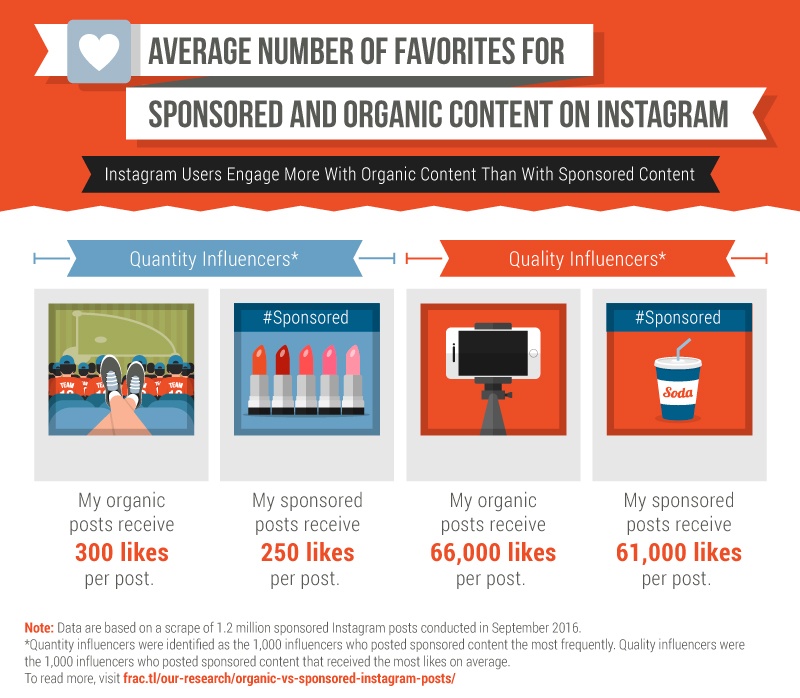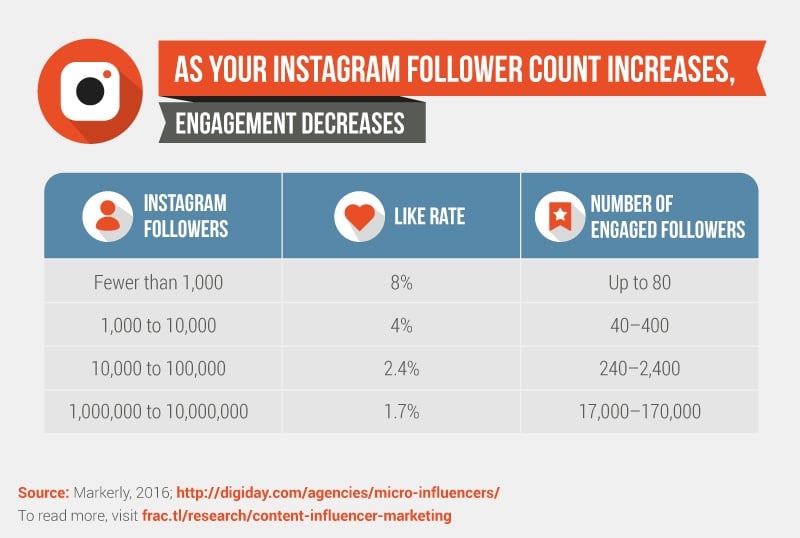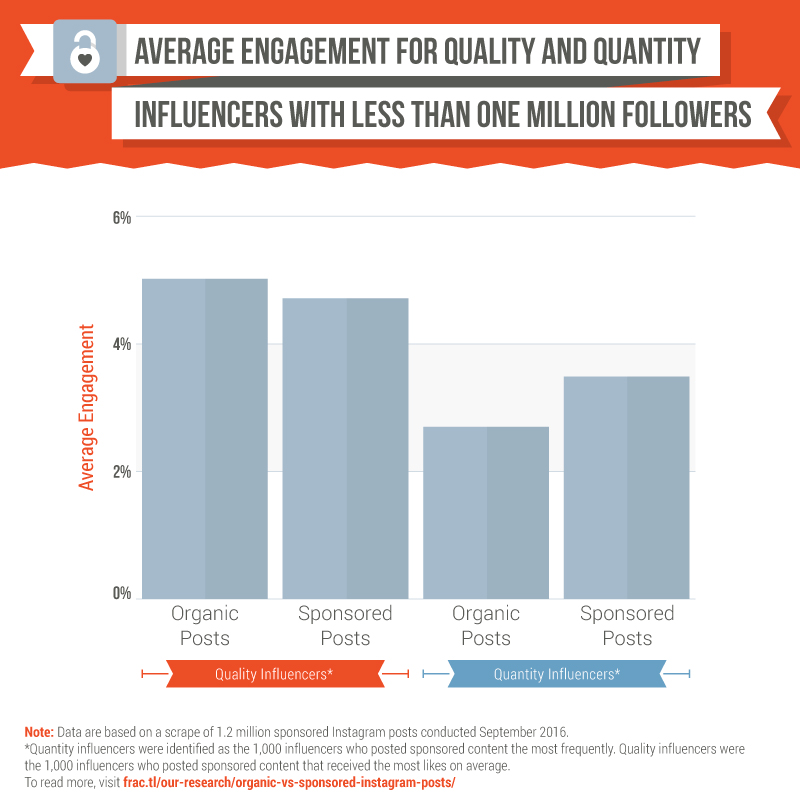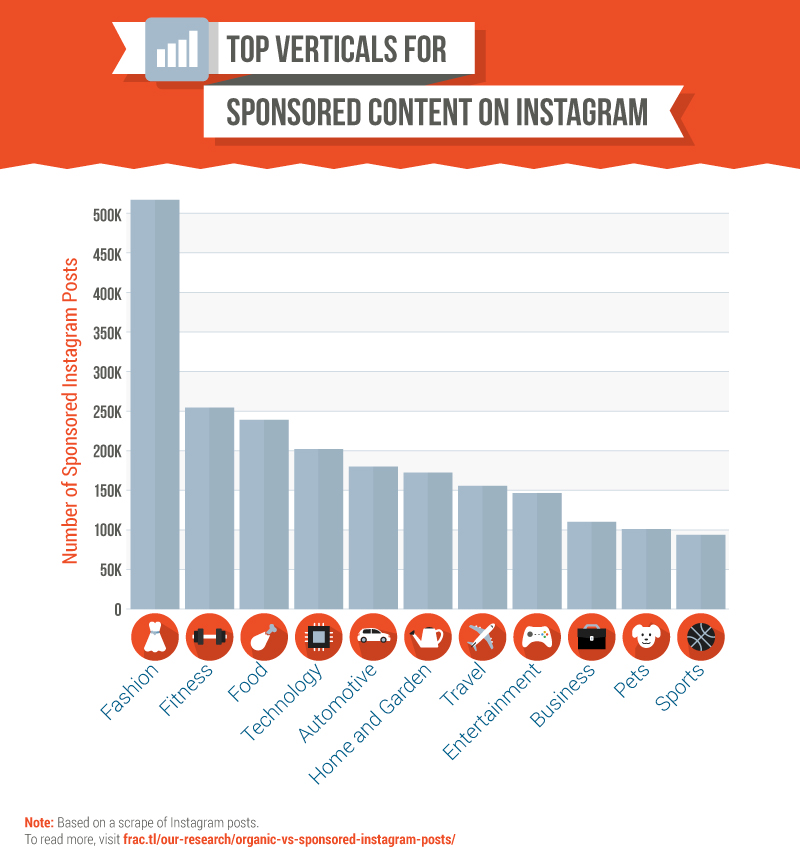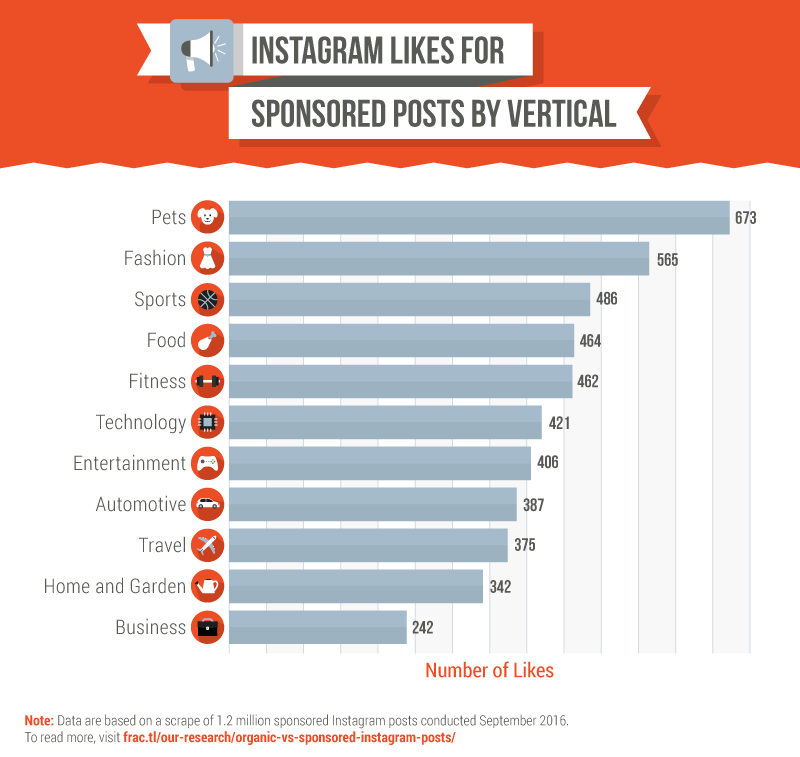Are an influencer’s sponsored posts as compelling to their audience as their other content? Companies considering influencer marketing may look at an influencer’s average level of engagement to determine whether they should partner with them. While average engagement level is a good measure of the strength of an influencer’s fan base, it may not be a good predictor of the success of a sponsored post.
Methodology
In September 2016, we scraped 1.2 million Instagram posts that included the tags #spon, #sponsored, #sponsoredby, #sponsoredpost, or #ad. We then scraped the 99 most recent posts (both organic and sponsored) created by:
- Quality influencers: The 1,000 influencers who received the most likes for their sponsored content.
- Quantity influencers: The 1,000 influencers who posted sponsored content the most frequently.
Only three Instagram users were on both lists, posting significant amounts of sponsored content that also received a high average number of likes. Overall, we found that organic content received more engagement than sponsored content for both of these groups.
What are the Differences Between Quality and Quantity Influencers?
Quantity influencers post far more sponsored posts.
- On average, 6.4 percent of quality influencers’ posts were sponsored,
- Compared with 59.7 percent of quantity influencers’ posts.
Quality influencers receive more likes on sponsored posts.
- For quality influencers, sponsored posts received 9 percent fewer likes on average (60,608 likes versus 66,390 likes).
- For quantity influencers, sponsored posts received 17 percent fewer likes on average (252 likes versus 300 likes).
For both quantity and quality influencers, sponsored content received less likes than organic content:
Quality influencers have significantly more followers on average.
- Quality influencers had an average of 2.6 million Instagram followers.
- Quantity Influencers had an average of 29,000 Instagram followers.
Excluding the Kardashians (and Friends)
Our list of quality influencers included powerhouses like Zach King, Kylie Jenner, and Kendall Jenner, whose organic Instagram posts regularly rack up over one million likes. Not only is purchasing an Instagram post from these celebrities prohibitively expensive for most companies, but it also may not be the most effective influencer marketing route. So what happened when we excluded Instagrammers with over one million followers?
When we excluded Instagram users with over one million followers, the landscape of quality and quantity influencers shifted slightly. But even after excluding big-name influencers, sponsored content generally received less engagement than organic content.
| Quantity Influencers | Quality Influencers | |
| Number of Followers, on Average | 18,287 | 573,161 |
| Percentage of Sponsored Posts, on Average | 60.6% | 6.6% |
| Likes per Organic Posts, on Average | 239 | 25,589 |
| Likes per Sponsored Posts, on Average | 224 | 23,697 |
| Percentage Difference in Engagement on Sponsored versus Organic Content | -6.5% | -8.3% |
What About Engagement Rates?
On Instagram, the more followers an influencer has, the lower their engagement rates.
Interestingly, even though quality influencers had over 31 times the number of followers as quantity influencers, on average, quality influencers had a higher level of engagement for both organic and sponsored content than quantity influencers.
When excluding influencers with more than a million followers,
- Quality influencers’ sponsored posts received an average engagement level of 4.7 percent (likes divided by the number of followers and influencer had).
- Quantity influencers’ sponsored content received an average engagement level of 3.5 percent.
What Types of Sponsored Posts Perform Best?
It’s been concluded that baseline engagement for sponsored content is consistently lower than engagement for organic content, but do certain types of sponsored posts perform better than others?
We classified posts as belonging to a certain vertical if particular keywords were included in the post caption or the post tags. Vertical distinctions were not mutually exclusive.
Most Common Types of Sponsored Content
- Fashion, Fitness, and Food were the most frequent types of sponsored posts.
- Quantity influencers had more of every type of keyword in their bios, captions, and tags, indicating some degree of keyword stuffing in their approach.
Most Engaging Types of Sponsored Content
Although Fitness and Food were two of the three most common types of sponsored posts, they did not receive the most likes per post.
- Sponsored Pets posts received an average of 673 likes on Instagram.
- Travel, a visual vertical, lagged behind on likes per sponsored post, with an average of 375 likes per post.
Sponsored content on Instagram received less engagement, on average, than organic content. Sponsoring content can be an effective part of a marketing strategy, but there are a few key things to keep in mind when choosing an influencer:
- Make sure your product is relevant to the influencer’s audience.
- Look at the average engagement for an influencer’s sponsored posts, not just their organic posts.
- Sponsored posts related to Pets, Fashion, and Sports receive the most likes per sponsored post.
For more help with an influencer marketing strategy, check out our guide to finding effective influencers.

